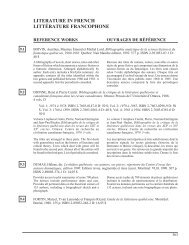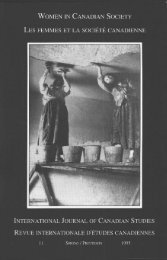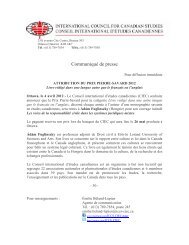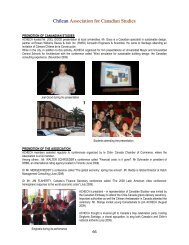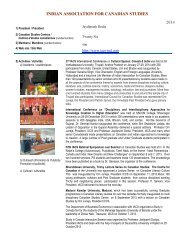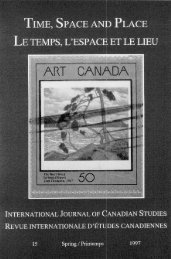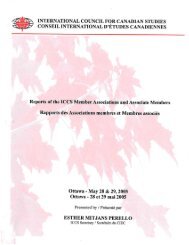Arts and Literature in Canada:Views from Abroad, Les arts et la ...
Arts and Literature in Canada:Views from Abroad, Les arts et la ...
Arts and Literature in Canada:Views from Abroad, Les arts et la ...
- No tags were found...
Create successful ePaper yourself
Turn your PDF publications into a flip-book with our unique Google optimized e-Paper software.
IJCS/RIÉCYou are not smitten with the shockOf that great thunder<strong>in</strong>g sky?Visual perspective <strong>in</strong> this poem emerges as the impoverish<strong>in</strong>g <strong>in</strong>strument of afearful m<strong>in</strong>d (“The fear has eaten back/Through sock<strong>et</strong>s to the caverns of thebra<strong>in</strong>”); it is designed to control space, to impose rational orientation onoverwhelm<strong>in</strong>g <strong>and</strong> potentially madden<strong>in</strong>g magnificence. To encounter thismagnificence with the imag<strong>in</strong>ation, “nonsensuously” <strong>and</strong> aperspectivally, is arisky enterprise, but only to the adventitious perceiver will the l<strong>and</strong>scapereveal its unseeable greatness.Margar<strong>et</strong> Atwood's “This Is a Photograph of Me” (1966), too, is concernedwith an artificial way of see<strong>in</strong>g; <strong>in</strong> fact, the s<strong>in</strong>gle lens of the camera fulfills thedem<strong>and</strong> of Renaissance perspective that the perspectival scheme beconstructed <strong>from</strong> a s<strong>in</strong>gle eye-po<strong>in</strong>t. The poem beg<strong>in</strong>s with a familiar“picture”—a portrait with a l<strong>and</strong>scape background: “In the background thereis a <strong>la</strong>ke,/<strong>and</strong> beyond that, some low hills.” L<strong>and</strong>scape <strong>and</strong> self seem to beseparate, but the next l<strong>in</strong>es reveal a col<strong>la</strong>pse of the two entities: the self hasdrowned <strong>and</strong> thus become a part of the l<strong>and</strong>: “I am <strong>in</strong> the <strong>la</strong>ke, <strong>in</strong> the center/ofthe picture, just under the surface.” See<strong>in</strong>g som<strong>et</strong>h<strong>in</strong>g <strong>in</strong> perspective requires am<strong>in</strong>imal distance b<strong>et</strong>ween subject <strong>and</strong> object; when self <strong>and</strong> l<strong>and</strong> are fused, thisdistance is nullified <strong>and</strong> the perspectival scheme accord<strong>in</strong>gly destroyed. Thedivision b<strong>et</strong>ween foreground <strong>and</strong> background suggested <strong>in</strong> the poem's first twol<strong>in</strong>es has been capsized— person becomes l<strong>and</strong>, foreground background, <strong>and</strong>the alleged background is foregrounded, tak<strong>in</strong>g the p<strong>la</strong>ce of where the personshould be. Subject <strong>and</strong> object unite <strong>in</strong> a s<strong>in</strong>gle picture p<strong>la</strong>ne. Apart <strong>from</strong> thecol<strong>la</strong>pse of its depth, the picture is also “f<strong>la</strong>wed” with respect to scale: “It isdifficult to say .../how <strong>la</strong>rge or small I am:/the effect of water/on light is adistortion ....” The crooked perspective <strong>in</strong> these l<strong>in</strong>es is a corre<strong>la</strong>tive to thebewilderment of the self, which, hav<strong>in</strong>g merged with the l<strong>and</strong>, must re-orientitself <strong>and</strong> develop new ways of re<strong>la</strong>t<strong>in</strong>g to its environment.Man's re<strong>la</strong>tion to the environment, the merg<strong>in</strong>g of self <strong>and</strong> l<strong>and</strong>, is at the corenot only of Atwood's art, but also of other Canadian poems of the <strong>la</strong>te 60s <strong>and</strong>70s—a period when Canadian literature was absorbed <strong>in</strong> questions of identity<strong>and</strong> pursued them with special attention to the Canadian man-naturere<strong>la</strong>tionship. 19 Nowhere is this re<strong>la</strong>tionship explored as obviously <strong>in</strong> Canadianterms as <strong>in</strong> The Journals of Susanna Moodie (1970). As <strong>in</strong> Avison's“Perspective,” the col<strong>la</strong>pse of vision <strong>in</strong> this cycle of poems is a precondition todevelop<strong>in</strong>g more appropriate modes of perception; “[v]isual perception limits<strong>and</strong> excludes. Inner vision alone leads to a full underst<strong>and</strong><strong>in</strong>g” (Grace 1980:34). At the same time, this col<strong>la</strong>pse symbolizes the breakdown of mentalperspectives. Mrs. Moodie, the British immigrant, is unable to underst<strong>and</strong> hernew country because the concepts with which she tries to do so are <strong>in</strong>congruentwith the country's realities.20



